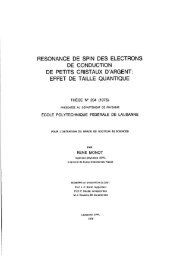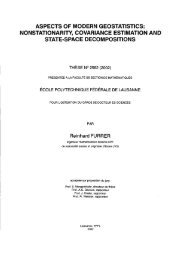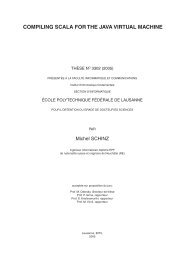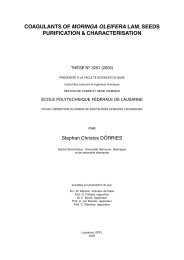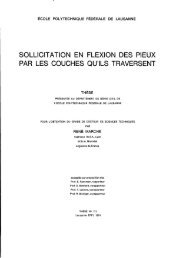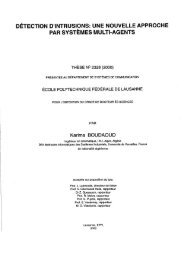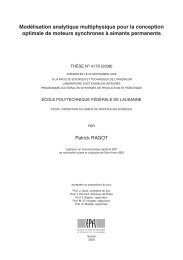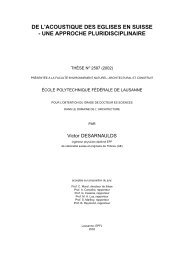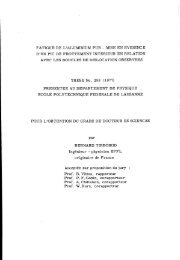New Slip Synthesis Theoretical Approach of CVT Slip Control
New Slip Synthesis Theoretical Approach of CVT Slip Control
New Slip Synthesis Theoretical Approach of CVT Slip Control
You also want an ePaper? Increase the reach of your titles
YUMPU automatically turns print PDFs into web optimized ePapers that Google loves.
<strong>New</strong> <strong>Slip</strong> <strong>Synthesis</strong> and <strong>Theoretical</strong> <strong>Approach</strong> <strong>of</strong><br />
<strong>CVT</strong> <strong>Slip</strong> <strong>Control</strong><br />
THÈSE N O 4337 (2009)<br />
PRÉSENTÉE LE13 MARS 2009<br />
À LA FACULTÉ SCIENCES ET TECHNIQUES DE L'INGÉNIEUR<br />
LABORATOIRE DE SYSTÈMES ROBOTIQUES 1<br />
PROGRAMME DOCTORAL EN SYSTÈMES DE PRODUCTION ET ROBOTIQUE<br />
ÉCOLE POLYTECHNIQUE FÉDÉRALE DE LAUSANNE<br />
POUR L'OBTENTION DU GRADE DE DOCTEUR ÈS SCIENCES<br />
PAR<br />
Yves ROTHENBüHLER<br />
acceptée sur proposition du jury:<br />
Pr<strong>of</strong>. M.-O. Hongler, président du jury<br />
Pr<strong>of</strong>. H. Bleuler, Pr<strong>of</strong>. J. Giovanola, directeurs de thèse<br />
Dr G. Carbone, rapporteur<br />
Dr Ph. Müllhaupt, rapporteur<br />
J. van Rooij, rapporteur<br />
Suisse<br />
2009
Contents<br />
Contents v<br />
Abstract ix<br />
Résumé xi<br />
1 Introduction 1<br />
1.1 Contribution . . . . . . . . . . . . . . . . . . . . . . . . . . . . 2<br />
1.2 Outlines . . . . . . . . . . . . . . . . . . . . . . . . . . . . . . . 3<br />
2 Belt or chain type continuously variable transmission 5<br />
2.1 Intermediate element . . . . . . . . . . . . . . . . . . . . . . . . 5<br />
2.1.1 Metallic belt . . . . . . . . . . . . . . . . . . . . . . . . 5<br />
2.1.2 <strong>CVT</strong>s chain . . . . . . . . . . . . . . . . . . . . . . . . . 5<br />
2.2 Hydraulic system . . . . . . . . . . . . . . . . . . . . . . . . . . 7<br />
2.3 <strong>CVT</strong> efficiency . . . . . . . . . . . . . . . . . . . . . . . . . . . 9<br />
2.3.1 Loss due to slip . . . . . . . . . . . . . . . . . . . . . . . 9<br />
2.3.2 Pump losses . . . . . . . . . . . . . . . . . . . . . . . . . 10<br />
2.3.3 Belt-related torque losses . . . . . . . . . . . . . . . . . 10<br />
2.4 Efficiency improvement strategies . . . . . . . . . . . . . . . . . 11<br />
2.4.1 Variator losses improvement . . . . . . . . . . . . . . . . 11<br />
2.4.2 Hydraulic losses . . . . . . . . . . . . . . . . . . . . . . 12<br />
2.5 System used in this thesis . . . . . . . . . . . . . . . . . . . . . 14<br />
2.6 Summary . . . . . . . . . . . . . . . . . . . . . . . . . . . . . . 14<br />
3 <strong>New</strong> slip synthesis 17<br />
3.1 Pulley slip . . . . . . . . . . . . . . . . . . . . . . . . . . . . . . 17<br />
3.2 <strong>New</strong> analysis <strong>of</strong> the total slip . . . . . . . . . . . . . . . . . . . 18<br />
3.3 Traction coefficients . . . . . . . . . . . . . . . . . . . . . . . . 20<br />
3.3.1 Micro and macro slip definition . . . . . . . . . . . . . . 22<br />
3.4 Discussion <strong>of</strong> new slip synthesis . . . . . . . . . . . . . . . . . . 22<br />
3.4.1 Standard slip synthesis . . . . . . . . . . . . . . . . . . . 22<br />
3.4.2 <strong>New</strong> slip synthesis . . . . . . . . . . . . . . . . . . . . . 23<br />
3.4.3 Comparison <strong>of</strong> the two synthesis . . . . . . . . . . . . . 24<br />
3.4.4 Remark . . . . . . . . . . . . . . . . . . . . . . . . . . . 25<br />
3.5 Efficiency . . . . . . . . . . . . . . . . . . . . . . . . . . . . . . 25<br />
v
vi CONTENTS<br />
3.6 Stability analysis with a simple model . . . . . . . . . . . . . . 28<br />
3.7 Summary . . . . . . . . . . . . . . . . . . . . . . . . . . . . . . 30<br />
4 Low level model 33<br />
4.1 State <strong>of</strong> the art . . . . . . . . . . . . . . . . . . . . . . . . . . . 33<br />
4.2 Geometric model <strong>of</strong> the variator . . . . . . . . . . . . . . . . . 34<br />
4.3 Steady-state model <strong>of</strong> the variator . . . . . . . . . . . . . . . . 37<br />
4.3.1 Kinematic model . . . . . . . . . . . . . . . . . . . . . . 37<br />
4.3.2 Mechanical model . . . . . . . . . . . . . . . . . . . . . 40<br />
4.3.3 Friction coefficient . . . . . . . . . . . . . . . . . . . . . 42<br />
4.4 Elastic deformation . . . . . . . . . . . . . . . . . . . . . . . . . 43<br />
4.4.1 Pulley deformation . . . . . . . . . . . . . . . . . . . . . 43<br />
4.4.2 Pulley sheave and shaft clearance . . . . . . . . . . . . . 45<br />
4.4.3 Pin compression . . . . . . . . . . . . . . . . . . . . . . 46<br />
4.4.4 Pulley radius deformation . . . . . . . . . . . . . . . . . 46<br />
4.5 Numerical procedure . . . . . . . . . . . . . . . . . . . . . . . . 48<br />
4.6 Intermediate element speed . . . . . . . . . . . . . . . . . . . . 49<br />
4.6.1 Geometrical ratio constant . . . . . . . . . . . . . . . . 49<br />
4.6.2 Speed ratio constant . . . . . . . . . . . . . . . . . . . . 50<br />
4.7 Efficiency model . . . . . . . . . . . . . . . . . . . . . . . . . . 50<br />
4.7.1 Hertz contact . . . . . . . . . . . . . . . . . . . . . . . . 50<br />
4.7.2 Friction forces and moments . . . . . . . . . . . . . . . . 51<br />
4.7.3 Chain efficiency . . . . . . . . . . . . . . . . . . . . . . . 53<br />
4.8 Simulation . . . . . . . . . . . . . . . . . . . . . . . . . . . . . . 54<br />
4.8.1 Chain forces and slip . . . . . . . . . . . . . . . . . . . . 55<br />
4.8.2 Variator matrix . . . . . . . . . . . . . . . . . . . . . . . 56<br />
4.8.3 Shifting . . . . . . . . . . . . . . . . . . . . . . . . . . . 56<br />
4.9 Summary . . . . . . . . . . . . . . . . . . . . . . . . . . . . . . 56<br />
5 High level model 59<br />
5.1 State <strong>of</strong> the art . . . . . . . . . . . . . . . . . . . . . . . . . . . 59<br />
5.1.1 Variator dynamics . . . . . . . . . . . . . . . . . . . . . 59<br />
5.1.2 Servo pumps modelling . . . . . . . . . . . . . . . . . . 60<br />
5.2 System interactions . . . . . . . . . . . . . . . . . . . . . . . . . 60<br />
5.2.1 Actuators interactions . . . . . . . . . . . . . . . . . . . 60<br />
5.2.2 Hydraulic and variator interactions . . . . . . . . . . . . 60<br />
5.3 Actuator models . . . . . . . . . . . . . . . . . . . . . . . . . . 60<br />
5.3.1 <strong>Control</strong> mode <strong>of</strong> the servo pump . . . . . . . . . . . . . 62<br />
5.3.2 Servo pump model . . . . . . . . . . . . . . . . . . . . . 62<br />
5.4 Hydraulic model . . . . . . . . . . . . . . . . . . . . . . . . . . 63<br />
5.5 Shifting model . . . . . . . . . . . . . . . . . . . . . . . . . . . 64<br />
5.6 <strong>Slip</strong> model . . . . . . . . . . . . . . . . . . . . . . . . . . . . . . 64<br />
5.7 Mechanical model . . . . . . . . . . . . . . . . . . . . . . . . . . 65<br />
5.8 Variator dynamics with slip . . . . . . . . . . . . . . . . . . . . 67<br />
5.8.1 Linearized model . . . . . . . . . . . . . . . . . . . . . . 67<br />
5.9 Summary . . . . . . . . . . . . . . . . . . . . . . . . . . . . . . 68
CONTENTS vii<br />
6 Simulation and experiment comparisons 69<br />
6.1 Test bench . . . . . . . . . . . . . . . . . . . . . . . . . . . . . 69<br />
6.1.1 Pulley radius measurement . . . . . . . . . . . . . . . . 70<br />
6.1.2 Chain speed measurement . . . . . . . . . . . . . . . . . 71<br />
6.2 Low level model . . . . . . . . . . . . . . . . . . . . . . . . . . . 71<br />
6.2.1 Clamping force . . . . . . . . . . . . . . . . . . . . . . . 71<br />
6.2.2 <strong>Slip</strong> and traction coefficient . . . . . . . . . . . . . . . . 71<br />
6.3 High level model . . . . . . . . . . . . . . . . . . . . . . . . . . 73<br />
6.3.1 Geometrical model validation . . . . . . . . . . . . . . . 75<br />
6.3.2 Variator model . . . . . . . . . . . . . . . . . . . . . . . 76<br />
6.4 Summary . . . . . . . . . . . . . . . . . . . . . . . . . . . . . . 76<br />
7 Variator control 81<br />
7.1 State <strong>of</strong> the art . . . . . . . . . . . . . . . . . . . . . . . . . . . 81<br />
7.2 Actuator flow control . . . . . . . . . . . . . . . . . . . . . . . . 82<br />
7.2.1 <strong>Control</strong> problem . . . . . . . . . . . . . . . . . . . . . . 83<br />
7.2.2 Flow control design with pole placement . . . . . . . . . 83<br />
7.2.3 Design validation <strong>of</strong> the flow control . . . . . . . . . . . 85<br />
7.3 Pressure control . . . . . . . . . . . . . . . . . . . . . . . . . . . 85<br />
7.3.1 Pressure control constraint . . . . . . . . . . . . . . . . 85<br />
7.3.2 Input-Output feedback linearization design . . . . . . . 85<br />
7.3.3 Pressure linear control design . . . . . . . . . . . . . . . 87<br />
7.4 Ratio and secondary clamping force control . . . . . . . . . . . 88<br />
7.4.1 Secondary clamping force control . . . . . . . . . . . . . 89<br />
7.4.2 Speed ratio control design . . . . . . . . . . . . . . . . . 89<br />
7.5 Validation <strong>of</strong> the variator control design . . . . . . . . . . . . . 90<br />
7.6 Summary . . . . . . . . . . . . . . . . . . . . . . . . . . . . . . 92<br />
8 <strong>Slip</strong> control 93<br />
8.1 State <strong>of</strong> the art . . . . . . . . . . . . . . . . . . . . . . . . . . . 93<br />
8.2 <strong>Slip</strong> control problem . . . . . . . . . . . . . . . . . . . . . . . . 93<br />
8.2.1 <strong>Slip</strong> control strategy . . . . . . . . . . . . . . . . . . . . 94<br />
8.2.2 Frequency response . . . . . . . . . . . . . . . . . . . . . 94<br />
8.3 <strong>Slip</strong> control with PI . . . . . . . . . . . . . . . . . . . . . . . . 96<br />
8.3.1 Simple feedforward design . . . . . . . . . . . . . . . . . 96<br />
8.3.2 Mapping feedforward design . . . . . . . . . . . . . . . . 97<br />
8.3.3 Bode diagram for the PI control . . . . . . . . . . . . . 97<br />
8.4 <strong>Slip</strong> control with model reference adaptive control . . . . . . . 97<br />
8.4.1 <strong>Slip</strong> control with MRAC . . . . . . . . . . . . . . . . . . 100<br />
8.5 <strong>Slip</strong> control performances . . . . . . . . . . . . . . . . . . . . . 102<br />
8.5.1 Efficiency gain . . . . . . . . . . . . . . . . . . . . . . . 102<br />
8.5.2 Torque perturbations . . . . . . . . . . . . . . . . . . . . 102<br />
8.5.3 Speed ratio perturbations . . . . . . . . . . . . . . . . . 105<br />
8.5.4 Frequency response . . . . . . . . . . . . . . . . . . . . . 106<br />
8.6 MRAC parameters . . . . . . . . . . . . . . . . . . . . . . . . . 108<br />
8.7 Summary . . . . . . . . . . . . . . . . . . . . . . . . . . . . . . 108
viii CONTENTS<br />
9 Conclusions and recommendations 111<br />
9.1 Recommendations . . . . . . . . . . . . . . . . . . . . . . . . . 113<br />
A Differential equations <strong>of</strong> the pulley slip 115<br />
A.1 Primary slip . . . . . . . . . . . . . . . . . . . . . . . . . . . . . 115<br />
A.2 Secondary slip . . . . . . . . . . . . . . . . . . . . . . . . . . . 116<br />
B Other figures 119<br />
B.1 Traction coefficient . . . . . . . . . . . . . . . . . . . . . . . . . 119<br />
B.2 Pulley radiuses and traction coefficients . . . . . . . . . . . . . 119<br />
B.3 Experiments and simulation . . . . . . . . . . . . . . . . . . . . 119<br />
B.4 Clamping force comparison . . . . . . . . . . . . . . . . . . . . 119<br />
C Pulley deformation comparison 127<br />
C.1 Sattler model . . . . . . . . . . . . . . . . . . . . . . . . . . . . 127<br />
C.2 Deformation comparison . . . . . . . . . . . . . . . . . . . . . . 127<br />
D Servo pump: detailed model 131<br />
D.1 Motor model . . . . . . . . . . . . . . . . . . . . . . . . . . . . 131<br />
D.2 Pump model . . . . . . . . . . . . . . . . . . . . . . . . . . . . 133<br />
D.2.1 Hydraulic model . . . . . . . . . . . . . . . . . . . . . . 133<br />
E Standard slip 135<br />
F Linearization 137<br />
G Testing facilities 141<br />
G.1 Electric motor . . . . . . . . . . . . . . . . . . . . . . . . . . . . 141<br />
G.2 Dynamo . . . . . . . . . . . . . . . . . . . . . . . . . . . . . . . 141<br />
G.3 Input and output sensor . . . . . . . . . . . . . . . . . . . . . . 141<br />
G.4 <strong>CVT</strong> variator . . . . . . . . . . . . . . . . . . . . . . . . . . . . 143<br />
G.5 Hydraulic system . . . . . . . . . . . . . . . . . . . . . . . . . . 143<br />
G.5.1 Servo amplifier . . . . . . . . . . . . . . . . . . . . . . . 143<br />
G.5.2 Servo motor . . . . . . . . . . . . . . . . . . . . . . . . . 143<br />
G.5.3 Pump . . . . . . . . . . . . . . . . . . . . . . . . . . . . 144<br />
G.6 Test bench control . . . . . . . . . . . . . . . . . . . . . . . . . 144<br />
H <strong>CVT</strong> Linear <strong>Control</strong> 145<br />
H.1 Transfer function . . . . . . . . . . . . . . . . . . . . . . . . . . 145<br />
H.2 Secondary pressure control . . . . . . . . . . . . . . . . . . . . . 146<br />
H.3 Ratio control . . . . . . . . . . . . . . . . . . . . . . . . . . . . 146<br />
Nomenclature 147<br />
Bibliography 151<br />
Curriculum Vitae 159
Abstract<br />
Today’s vehicle must be efficient in terms <strong>of</strong> gas (CO2, NOx) emissions and<br />
fuel consumption. Due to improvements in material and oil, the continuous<br />
variable transmission (<strong>CVT</strong>) is now making a breakthrough in the automotive<br />
market. The <strong>CVT</strong> decouples the engine from the wheel speed. <strong>CVT</strong> enables<br />
significant fuel gains by shifting the engine operating point for specific power<br />
demands. This optimization <strong>of</strong> the operating point enables a reduction <strong>of</strong> this<br />
fuel consumption.<br />
A <strong>CVT</strong> is constituted <strong>of</strong> two pulley sheaves, one fixed and the other one<br />
movable in its axial direction when subjected to an external axial force, in<br />
general hydraulic. The transition from the minimum to the maximum speed<br />
ratio is continuous and an infinite numbers <strong>of</strong> ratio is available between these<br />
two limits. An intermediate element (a metallic belt or chain) transmits the<br />
power from the input (the primary) to the exit (the secondary) <strong>of</strong> the <strong>CVT</strong><br />
or variator.<br />
Further improvements <strong>of</strong> the fuel consumption and gas emission are still<br />
required for example by improving the variator efficiency. Increasing hydraulic<br />
performance or decreasing mechanical losses by reducing the axial forces are<br />
some solutions. The latter method is not without risks. The diminution <strong>of</strong> the<br />
clamping forces increases the slip between pulley sheaves and the intermediate<br />
element. If the axial forces decrease too much, high slip values can be reached<br />
and cause damage to the pulleys and the intermediate element. <strong>Control</strong> <strong>of</strong> the<br />
slip is an attractive solution to decrease the clamping forces in order to safely<br />
improve the variator efficiency.<br />
The objective <strong>of</strong> this thesis is to understand and model the slip <strong>of</strong> each<br />
pulley and establish analytic tools dedicate to the variator control. The slip<br />
study and the theoretical approach <strong>of</strong> the <strong>CVT</strong> variator is applied to the slip<br />
control <strong>of</strong> the variator with a chain.<br />
The contribution <strong>of</strong> this work is threefold. Firstly, the slip and the traction<br />
coefficient are analyzed for each pulley. The slip analysis <strong>of</strong> each pulley<br />
is then used to define a new slip synthesis as the summation <strong>of</strong> the slip <strong>of</strong><br />
each pulley. It is demonstrated that the slip and the traction coefficient are<br />
different for each pulley and depend on the speed ratio <strong>of</strong> the variator. In low<br />
ratios, both the secondary pulley and the primary pulley slip, but only the<br />
primary reaches macro slip. For middle or higher ratios, only the secondary<br />
pulley slips and reaches high values <strong>of</strong> slip. Experiments show that the pulley<br />
with the smallest clamping force limits the system. Secondly, based on<br />
ix
x CONTENTS<br />
kinematics, force equilibrium, elastic deformations <strong>of</strong> the pulleys and the intermediate<br />
element, a detail model <strong>of</strong> the variator is proposed. The principal<br />
results are the estimation <strong>of</strong> the clamping forces, <strong>of</strong> the traction curve for each<br />
pulley and <strong>of</strong> the chain efficiency. These results are implemented in a simpler<br />
model that describes the variator dynamics. This last model considers the<br />
two pulleys and the intermediate element as free bodies. The hydraulic circuit<br />
and the actuators, which are important to take into account for control, are<br />
also modeled. Thirdly, the new slip synthesis and the results <strong>of</strong> the dynamic<br />
models are applied to the slip control <strong>of</strong> the variator in order to improve the<br />
efficiency. A pole placement law is applied to the actuators to control the flow<br />
that enters or exits the pulleys. With this law, the actuators are decoupled and<br />
the bandwidth is increased sufficiently for actuators dynamics to be neglected.<br />
The primary and the secondary pressures are decoupled and linearized by an<br />
input-output feedback linearization. The resulting system is linear and linear<br />
control theory can be applied to control the two pressures. The speed ratio is<br />
controlled by the primary clamping force. The secondary pressure is chosen<br />
as a function <strong>of</strong> the control mode <strong>of</strong> the variator: standard mode or slip mode.<br />
In standard mode, the intermediate element is overclamped by 30%, whereas<br />
in slip mode, the secondary clamping force is set as a function <strong>of</strong> the desired<br />
slip. By controlling the slip at 2%, the mechanical efficiency was increased<br />
by more than 2% and the clamping forces reduced by more than 30%. For<br />
the slip control, a proportional-integrator law and a model reference adaptive<br />
control (MRAC) are presented and the performances compared. The MRAC<br />
gives slightly better results.<br />
Keywords: <strong>CVT</strong>, variator, metallic belt, chain, slip, traction, efficiency,<br />
pole placement, non-linear control, model reference adaptive control (MRAC).
Résumé<br />
De nos jours, les fabricants de voitures doivent de plus en plus faire face<br />
aux exigences d’émission de CO2 et NOx. Les récents progrès technologiques<br />
dans les domaines des matériaux, des huiles de lubrification, ont permis l’essort<br />
des boîtes à vitesses continue (Continuous Variable Transmission, <strong>CVT</strong>). Ces<br />
transmissions découplent la vitesse du moteur par rapport à celle des roues.<br />
Son utilisation permet d’optimiser le point d’opération du moteur pour une<br />
puissance donnée. Cette optimisation permet une réduction de la consommation<br />
d’essence.<br />
Une <strong>CVT</strong> est constituée d’une poulie dont une moitié est fixe et l’autre<br />
mobile dans sa direction axiale sous une certaine force externe, en général<br />
sous forme hydraulique. La transition du rapport minimum au rapport maximum<br />
est continue et une infinité de rapports de transmission est possible<br />
entre ces deux bornes. Un élément intermédiaire (une courroie métallique ou<br />
une chaîne) transmet la puissance entre l’entrée (le primaire) et la sortie (le<br />
secondaire) de la boîte à vitesses, aussi appelée variateur.<br />
Il est encore possible de diminuer l’émission des gaz en augmentant le rendement<br />
de la transmission, par exemple en améliorant le système hydraulique,<br />
ou en diminuant les pertes mécaniques par une réduction des forces axiales<br />
de serrage. Cette dernière méthode n’est pas sans risque. La diminution des<br />
forces de serrages augmente le glissement entre les poulies et l’élément intermédiaire.<br />
Si des grandes valeurs de glissement sont atteintes, les poulies<br />
et l’élèment intermédiaire peuvent être endommagés. En contrôlant le glissement,<br />
il est donc possible de diminuer les forces dans le système et d’augmenter<br />
le rendement en toute sécurité.<br />
L’objectif de cette thèse est d’étudier le glissement de chaque poulie et<br />
d’établir une approche théorique dédiée au contrôle du variateur. Cette nouvelle<br />
définition du glissement ainsi que cette approche théorique du modèle<br />
de la <strong>CVT</strong> sont appliquées au contrôle du glissement d’un variateur et d’une<br />
chaîne comme élément intermédiaire.<br />
Trois contributions de ce travail méritent d’être soulignées. Premièrement,<br />
le glissement et le coefficient de traction sont analysés pour chaque poulie et<br />
additionnés pour estimer le glissement total du variateur. Il est montré que<br />
le glissement et le coefficient de traction sont différents pour chaque poulie et<br />
dépendent du rapport de transmission. Dans les bas rapports, le secondaire<br />
et le primaire glissent, mais seulement le primaire atteint de grandes valeurs<br />
de glissement. En revanche, dans les moyens et hauts rapports, seul le sec-<br />
xi
xii CONTENTS<br />
ondaire glisse. Les expériences montrent que la limite du système (grandes<br />
valeurs de glissement) est atteinte par la poulie avec la plus petite force de<br />
serrage. Deuxièmement, basé sur la cinématique, l’équilibre des forces, la<br />
déformation des poulies et de l’élément intermédaire, un modèle détaillé du<br />
variateur est obtenu. Les principaux résultats consistent en une estimation<br />
des forces de serrage, de la courbe de traction de chaque poulie et du rendement<br />
de la chaîne. Ces résultats sont utilisés dans un modèle plus simple qui<br />
décrit la dynamique du variateur. Ce modèle considère les poulies et la chaîne<br />
comme des éléments indépendants. Il décrit également la dynamique du circuit<br />
hydraulique et des actionneurs, éléments importants à considérer pour le<br />
contrôle. Troisièmement, la nouvelle définition du glissement et les résultats<br />
des modèles sont appliqués au contrôle du glissement dans le but d’augmenter<br />
le rendement du variateur. La stratégie du placement de pôles découple les<br />
actionneurs et augmente leurs bandes passantes. Les bandes passantes des actionneurs<br />
deviennent suffisamment élevées par rapport au reste du système et<br />
les actionneurs peuvent être négligés. Un contrôle non linéaire de l’entrée sur la<br />
sortie (input-output feedback linearization) linéarise et découple les pressions<br />
de chaque poulie. Le système étant devenu linéaire, les théories du contrôle<br />
linéaire peuvent être utilisées pour contrôler les deux pressions. La pression du<br />
primaire est utilisée pour contrôler le rapport de transmission et la pression<br />
du secondaire est choisie en fonction du mode de contrôle: mode standard,<br />
mode de glissement. En mode standard, la chaîne est surserrée de 30%; en<br />
mode de glissement, elle est asjutée en fonction de la valeur de glissement<br />
désirée. Ce dernier mode augmente le rendement mécanique du variateur de<br />
2% et diminue les forces de serrage de plus de 30%. Pour le contrôle du glissement,<br />
un proportionnel-intégrateur (PI) et un contrôle adaptatif avec modèle<br />
de référence (Model Reference Adaptive <strong>Control</strong>, MRAC) sont présentés et<br />
les performances comparées. Les performances du MRAC sont légèrement<br />
meilleures que le PI.<br />
Mots Clés: <strong>CVT</strong>, variateur, courroie metallique, chaîne, glissement, traction,<br />
rendement, placement de pôle, contrôle non linéaire, contrôle adaptif avec<br />
modèle de référence.



